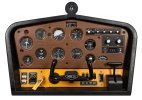Chip Sylverne
Final Approach
- Joined
- Jun 17, 2006
- Messages
- 5,935
- Display Name
Display name:
Quit with the negative waves, man.
An actual, operating Link trainer.
I coulda swore we did that on private.Yep, did em on commercial single

BFRThings that I learned that are gone:
-Position and hold-HIWAS-Flight Watch-LORAN-NDB/ADF's-A time when calling 1800 wx brief was actually useful and wasn't 45 separate menus.-Doctor killers were Bonanza's, not Cirri.
L16Things that I learned that are gone:

That, at least, hasn't changed. Listen to 122.8 lately?Sharing UNICOM with 5 other small airports meant we had channel congestion on sunny days, with only one or two local pilots up in the pattern.
Still exist.TRSAs
And Control Zones and Airport Traffic Areas....oh my!!!TCAs, ARSAs, TRSAs.
They seem greatly reduced in quantity today, and that’s a change...Still exist.
About a month ago, my home drome changed from 122.8 to 122.975. Absolutely amazing, how quiet the CTAF has become.That, at least, hasn't changed. Listen to 122.8 lately?
My private pilot certificate was issued in 1968; my first BFR was in November 1974, so the rule had to be implemented some time in the 1972-74 range.Biennial Flight Review started in the late 70s/early 80s. I remember doing them as a CFI in 1983.
No, that was the eye exam.
There are more than you'd think (or, at least, more than _I_ thought). The wikipedia page for TRSAs lists 30.They seem greatly reduced in quantity today, and that’s a change.
My Home Drome is changing CTAF from 112.7 this Fall along with the Designator (But not the name thankfully). I’m sure the 80/20 rule will be demonstrated.About a month ago, my home drome changed from 122.8 to 122.975. Absolutely amazing, how quiet the CTAF has become.
As usual, some people didn't get the word. The day it switched (MONTHS notice of the change), I turned on my handheld and within two minutes, someone tried to call in on the old frequency. Quickly swamped by calls telling the pilot the frequency had changed. In one case, the pilot gave a plaintive call about "What FREQUENCY did it change to?" Result was just a squeal as a bunch of people tried to tell him at once. Great fun.
I was really cringing when the change was announced, but after a couple of weeks, I'm pretty happy with it. Even if you can't understand the transmission, you know it's at least talking about your field.
Ron Wanttaja

Is steep spirals over a point still taught.??
My instructor told me I enjoyed that too much...
Oh. You learned on the new one.
I had to buy a fowl.Oh. You learned on the new one.
It’s purely political…politicians don’t want to admit that behavioral compasses have a true north, so they move magnetic north around to suit their purposes.Anyone notice how much magnetic variation has changed in the last 40 or so years? Crazy…must be the global climate change stuff in action?
Used to rent a Citabria with CAP for $10/hour. Bird Dog for $13. I got all the Bird Dog time because all the cheap pilots didn't want to spend the extra $3.....Cost!!! When I was learning to fly, I could rent a C-150 for less than $15/hour. They had a monthly special as low as $8.50/hour.
About a month ago, my home drome changed from 122.8 to 122.975. Absolutely amazing, how quiet the CTAF has become.
As usual, some people didn't get the word. The day it switched (MONTHS notice of the change), I turned on my handheld and within two minutes, someone tried to call in on the old frequency. Quickly swamped by calls telling the pilot the frequency had changed. In one case, the pilot gave a plaintive call about "What FREQUENCY did it change to?" Result was just a squeal as a bunch of people tried to tell him at once. Great fun.
I was really cringing when the change was announced, but after a couple of weeks, I'm pretty happy with it. Even if you can't understand the transmission, you know it's at least talking about your field.
Ron Wanttaja
I'm not so sure about that, assuming the student is paying for the airplane and CFI in the "normal" way. If somebody is giving them flight time for free, or their parents own an airplane, or they get a scholarship or anything like that, then of course it's possible, but I don't think that's what you were hoping for.$400 in 1965 is almost 4 grand. I'd like to think a determined person could find a way to get PPL on 4 grand. A flying club maybe?
